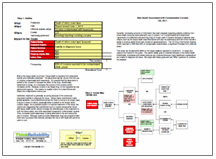By Kim Smiley
The National Institutes of Health (NIH) has announced that production of drugs for use in clinical studies has been suspended after fungal contamination was found in two vials of product. The exact source of the contamination has not been identified, but a recent Food and Drug Administration (FDA) inspection of the facility that prepares the contaminated product found multiple deficiencies, including issues with both the facility and work practices.
 This issue can be analyzed by building a Cause Map, a visual root cause analysis that intuitively lays out the cause-and-effect relationships that contribute to an issue. The first step of the Cause Mapping process is to determine how an issue impacted the overall goals. In this example, the safety goal is impacted because 6 patients were unknowingly given potentially contaminated drugs. These patients received vials of product from the same batch as the 2 vials found to be contaminated prior to the contamination being identified. None of the patients have shown signs of illnesses, but they will continue to be monitored. Additionally, the safety goal is impacted because some patients will knowingly be given potentially contaminated drugs. These patients are due for treatment imminently with no alternative available and the risk of delayed treatment has been determined to be greater than the risk of using the products. The schedule goal is also impacted as clinical trials are being delayed because the necessary medications aren’t available.
This issue can be analyzed by building a Cause Map, a visual root cause analysis that intuitively lays out the cause-and-effect relationships that contribute to an issue. The first step of the Cause Mapping process is to determine how an issue impacted the overall goals. In this example, the safety goal is impacted because 6 patients were unknowingly given potentially contaminated drugs. These patients received vials of product from the same batch as the 2 vials found to be contaminated prior to the contamination being identified. None of the patients have shown signs of illnesses, but they will continue to be monitored. Additionally, the safety goal is impacted because some patients will knowingly be given potentially contaminated drugs. These patients are due for treatment imminently with no alternative available and the risk of delayed treatment has been determined to be greater than the risk of using the products. The schedule goal is also impacted as clinical trials are being delayed because the necessary medications aren’t available.
The next step is building the actual Cause Map by starting at one of the impacted goals and asking “why” questions. So why were the drugs contaminated? It hasn’t been released what specifically lead to the fungal contamination and it may never be known, but the FDA found deficiencies within the facility that could lead to contamination. The inspectors observed workers working with sterile products with protective gear worn inappropriately so that skin and facial hair were exposed. Issues with the facility itself was also noted, both in the design of sterile work spaces and in the cleanliness of the spaces. Inspectors determined that the air handling system for the clean rooms wasn’t adequately designed to ensure physical separation from the other spaces. Additionally, a filter was missing on the air handling system. The problems with cleanliness of clean rooms included insects found in 2 of 5 clean room ceiling light bays.
The investigation into these issues is ongoing and officials are working to ensure the safety of all products. As more information becomes available, it can easily be added to the Cause Map. Once the specific problems with the work processes and facility have been determined, specific solutions can be implemented to address the many issues found by investigators. This problem is one that clearly doesn’t have “one root cause”, but rather many causes that contributed to the problem and more than one solution will be needed to reduce the risk of contamination to an acceptable level.




